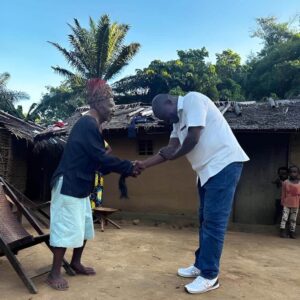Project contributors: Jonathan Barnard and John DeMarco

The forest-farm boundary at the Kilum-Ijim Forest was agreed by participatory decision-making with local communities. Photo: Jonathan Barnard / BirdLife International
Cameroon is among the top ten countries in Africa for its high biodiversity and cultural diversity. The rich montane forests of the Cameroon Mountains have high numbers of endemic plant, bird, amphibian, reptile, mammal, and insect species. However, some areas have been cleared, such as the Bamenda Highlands montane forest, where very little remains due to years of logging, farming, and grazing. It is estimated that if clearing had continued unabated, the Kilum-Ijim Forest (the largest remaining patch of Bamenda Highlands montane forest) might have completely disappeared by 1997. The Kilum-Ijim Forest Project is considered to be one of the pioneers of community forestry in Cameroon and is widely regarded as a model of how communities can manage their forests for both biodiversity conservation and to meet their own needs. When other communities learned of what was happening at Kilum-Ijim, they came to visit the project in order to learn more about conserving their own forests.
The “Bamenda Highlands Forest Project” was set up as a collaborative partnership between BirdLife International, the Government of Cameroon, and the communities of Cameroon’s Bamenda Highlands, to help those interested communities outside Kilum-Ijim. Rather than imposing conservation on the communities involved, the project’s approach was to encourage people to share the many reasons that they already had for valuing the forest, including reasons that were not widely known or were nearly forgotten by the communities themselves. Now there are more than twenty Forest Management Institutions (FMI) along with traditional management institutions that are active in the region, directly managing the forests without project assistance. The FMIs are community-based organizations (CBOs) that are necessary for the Community Forestry law in Cameroon. They comprise a number of roles relating to the planning and management of the forest and reporting to the government, and people are elected from the local communities concerned to fulfill these roles. The project facilitated the establishment of these CBOs and then helped them in their development, ensuring due regard to governance and transparency. The FMIs are still functioning without the presence of the BirdLife project.
The largest tribal groups in the area decided to form two umbrella organizations to support each other better: the Association of Kom Forest Management Institutions and the Association of Oku Forest Management Institutions. There are also several local NGOs now active in supporting communities for local forest management, most of which were initially assisted by the project in terms of capacity building. Local practices, beliefs, and languages associated with biodiversity have been revitalized, and forest boundaries and biodiversity have stabilized. While not an explicit objective of the project, the frequent and ongoing discussions about the forest have helped to revive and pass on local knowledge and elements of language to more people, including younger generations. All written materials and all species names are in the local language. Special attention is given to key medicinal plants from the forest, whose loss would have a major impact on the local practice of traditional medicine. Special efforts are made to protect an endemic local bird of great cultural significance, Bannerman’s Turaco, which symbolizes the close links between culture and biodiversity, and whose extinction would have a significant impact on local practices. Under its obligation as a signatory to the Convention on Biological Diversity, the national government has supported the revitalization of the important cultural values of these forests, which would have likely been lost to extractive forestry practices.



